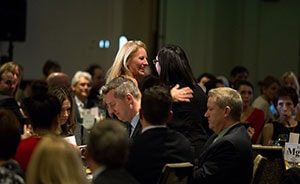The following is a partial transcript of a question-and-answer session, conducted over the FSH Society’s Facebook page, with Julie Hershberg, PT, DPT, NCS. Hershberg is a physical therapist who is a Board Certified Neurologic Specialist. She practices at [re+active] physical therapy & wellness and is an instructor in Doctor of Physical Therapy program at USC.
I have slowly continuing loss in what I think are my paraspinal muscles. What specific exercises can I do to help me improve my “pitch forward” posture?
The paraspinal muscles are the muscles that run along either side of your spine and include either the superficial erector spinae muscle group or the deep multifidi muscles. There is a vast amount of research looking specifically at which exercises best isolate these muscle groups. For trunk and back stability, it has been indicated to train the deeper multifidi muscles. It is difficult to recommend one particular exercise without knowing your ability, but some of my favorite exercises include the bridge, exercises on hands and knees, and lying on your stomach and lifting your legs and/or back. I cannot overemphasize how important it is to have an individual evaluation to determine which of these types of exercises are best for you. It is easy to compensate and perform the exercises incorrectly and therefore injure yourself—so I recommend a PT evaluation to set up exercises specific for you.
The “pitch forward” posture can have several causes that I like to examine to determine the best intervention. Some of the common causes include tight hip flexors, hamstrings, or calves, and weakness in abdominals, hip extensors, legs, and back muscles. The position and the posture of the head and neck can also be implicated. Again, I recommend a thorough PT movement evaluation to determine the underlying problems and guide you to the best treatment.
Would you explain myofascial release and where I can direct a PT to go for information and training? No one in my rural area is doing this.
Myofascial release is a special type of massage or soft tissue mobilization. The most popular form has been developed and taught by physical therapist John F Barnes. However, there are other methods. Many PTs and massage therapists practice different types of myofascial release, and I do not prescribe to one particular method, but a common element is this idea of gentle, sustained pressure. A definition from the John Barnes website: “Myofascial release is defined as a safe and very effective hands-on technique that involves applying gentle sustained pressure into the myofascial connective tissue restrictions to eliminate pain and restore motion. This essential “time element” has to do with the viscous flow and the piezoelectric phenomenon: a low load (gentle pressure) applied slowly will allow a viscoelastic medium (fascia) to elongate.” You can find a therapist trained in his specific techniques at https://www.myofascialrelease.com/find-a-therapist/.He also has some resources in Massage Magazine on techniques: http://www.massagemag.com/practice/technique-articles/.Finally, there are a lot of videos on YouTube under myofascial techniques or release that may be a good resource for your PT.
Another thing to think about: Often, new graduates and even PT students have a good background in these techniques because they are newer. You may benefit from working with a student who is doing an internship at your local clinic


Leave a Reply